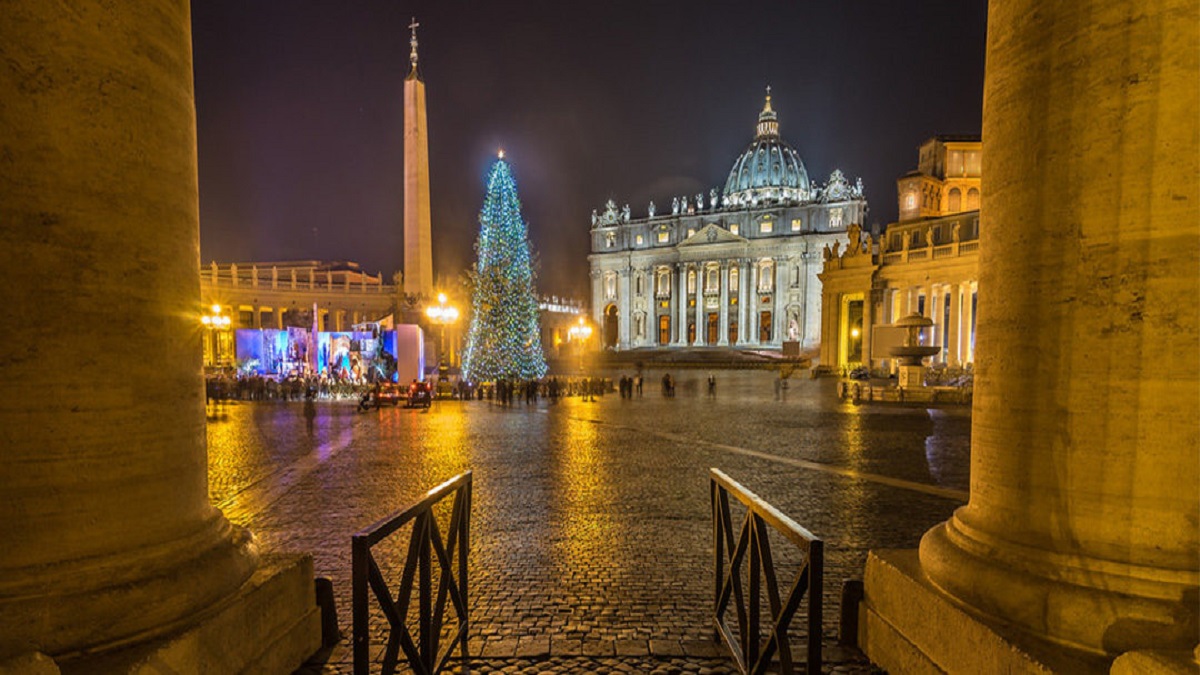CHRISTMAS IN ST. PETER’S SQUARE

Introduction
December 2018: It’s Christmas in St. Peter’s Square! The symbols of Christmas are shining in St Peter’s Square, surrounded by Bernini’s columns, to bring cheer to the Romans, the faithful and tourists alike. The tree and the presepe, the nativity scene, were inaugurated on December 7th and will be removed on Sunday, January 13th 2019. […]
Tools
Supplies
December 2018: It’s Christmas in St. Peter’s Square!
The symbols of Christmas are shining in St Peter’s Square, surrounded by Bernini’s columns, to bring cheer to the Romans, the faithful and tourists alike.
The tree and the presepe, the nativity scene, were inaugurated on December 7th and will be removed on Sunday, January 13th 2019.
When did this Custom Begin?
In 1982 Saint John Paul II had a nativity scene placed at the foot of the obelisk and a tree on its right hand side, bringing popular traditions into the quintessential Catholic institutional location, the seat of the Supreme Roman Pontiff.
Before this event, only the internal areas of the Vatican were decorated for Christmas.
The Christmas tree: Homage to a Nordic Tradition
Introduced due to is symbolic nature (Christ is the ‘evergreen’ who never dies), the custom of using a fir tree for Christmas was born in the Germanic world. During the Middle Ages, on December 24th, religious scenes were set up telling the story of Adam and Eve, recreating the setting of Paradise using fir trees decorated with red apples. Later these trees were embellished with food and candles, replaced in the nineteenth century by blown glass balls.
In 1982 the Vatican bought the Christmas tree from the Castelli Romani, but the following year several European mountain regions wanted to donate a tree to the Vatican, giving rise to long waiting lists.
The first fir tree was 14 metres tall, but some of its successors came to challenge even the obelisk with their height, (the Austrian Christmas tree in 2000 was 33 metres tall, and the tree from Calabria in 2006 was 34 metres tall). Italy and Austria can boast of offering the most fir trees to the Vatican.
In 1996, the fir tree was 76 years old, the same age as the Pope. Cardinal Castillo Lara commented: “They grew up together and found themselves together at the heart of the world”.
A Choice that Respects Nature
The fir tree from 1982 was replanted in the Vatican gardens. Successively, elder firs were chosen, whose removal would have favoured the growth of the neighbouring trees. Almost all of them come from certified forests, where replanting followed the cutting down of the trees.
Once the tree is taken down, its wood is recycled into objects that are sold to raise money for charity.
Il Presepe – The Nativity Scene: an Italian tradition
Presepe literally means manger, in memory of where the Baby Jesus was placed. It is a custom dating back to Saint Francis of Assisi in the Italian Middle Ages.
The St. Peter’s Square’s nativity scenes (designed by qualified Vatican personnel) that were created under John Paul II’s papacy were inspired by the classical hut with its pitched roof, while those under Benedict XVI were embellished with many characters and activities.
The Christmas of Pope Francis
For Francis, Christmas is an opportunity for the inclusion for the poor, the sick and the marginalized. His papacy has legitimized alternative artistic forms, so for the first time in 2016, the nativity scene was not created by Italian artists, but by the Maltese artist Manwel Grech, who reproduced the landscape of his native island, with a typical Maltese boat to bring to light the drama of migrants in the Mediterranean
In 2017 the decorations for the tree were made by children from the oncology wards of some Italian hospitals.
For Christmas 2018 the fir tree comes from the Friuli Venezia Giulia region, while the nativity scene is a gift from the city of Jesolo (province of Venice) and the Patriarchate of Venice. It doesn’t follow the traditional style, but is made of sand: an unusual and original artistic choice. Sand sculpturing is an art form that has recently come to the public’s attention, also thanks to international sand sculpturing festivals. 700 tons of sand from the Jesolo coast has been donated to the Vatican to create “Sand Nativity”, designed by four international artists. (for more information: www.jesolosandnativity.it).